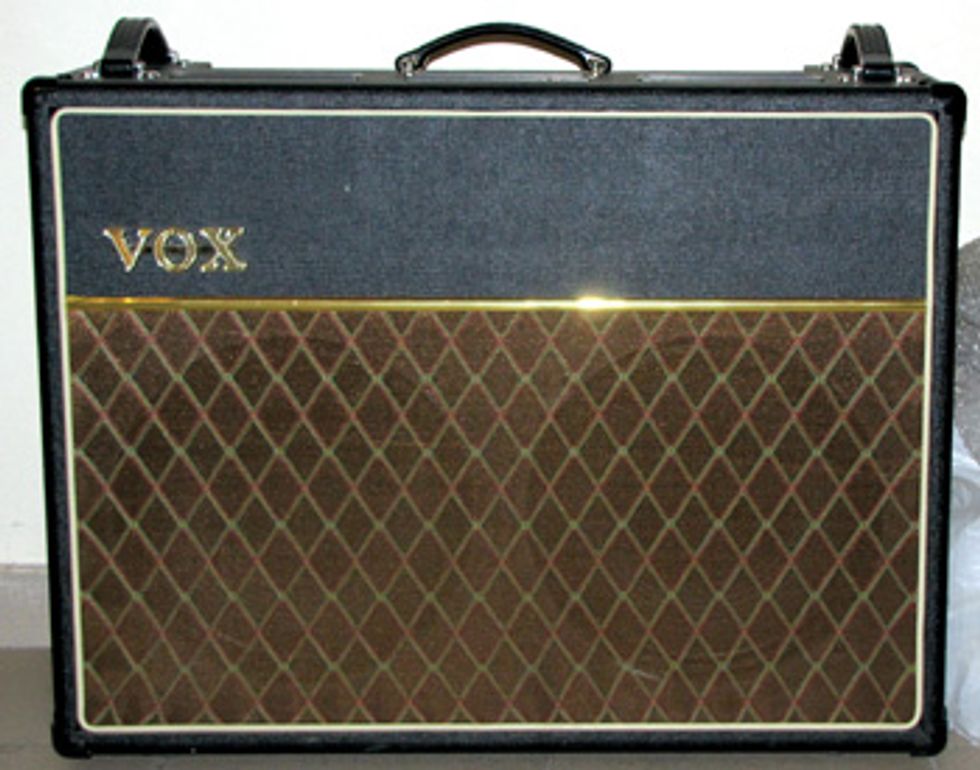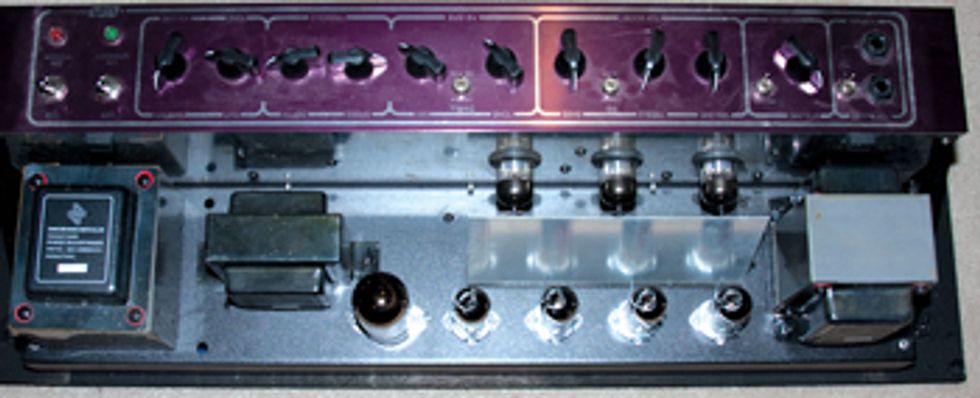
A 2008 Vox AC30 CC2. This 2x12 combo is powered by a quartet of EL84 tubes and has an output of 30-40 watts.

The AC30 CC2’s chassis.
Hi Jeff,
I’d really enjoy hearing your thoughts
on the 2008 Vox AC30 CC2 our
band bought new.
This amp has a history of eating power tubes and rectifier tubes. A few months ago, our new amp technician had a look at it and told us to stop using the standby switch, whether on start up or shut down. I’m not very technical, but his explanation was along the lines that after the warm up on standby, when the switch was flipped the rectifier tube overloaded the power tubes with current. I’m paraphrasing and I don’t wish to misquote the guy. He mentioned that at some point Vox started adding a resistor to the standby switch on this model to prevent malfunction, and reminded us that the original JMI AC30s didn’t have a standby switch.
His rule of thumb is that if the
amp has a rectifier tube, he doesn’t use
the standby switch. We haven’t had a
single problem with the amp after we
completely stopped using the standby
switch. Is this a wives’ tale or sound
advice? Keep up the great work!
Regards,
Luis Fernandez
Hi Luis,
Let’s take a look at why a standby switch
is included in most amps and see if your
technician has given you some sound advice.
A standby switch was included as a feature
on tube guitar amplifiers, not to give the
player instant access to the amp’s performance
mode, but actually for a much more
important reason—the preservation of the
tubes themselves. For proper, long-term
operation of a tube, theoretically it should
be heated to its operating temperature
prior to applying high voltage to its internal
components.
When high voltage is applied before the tube reaches its operational temperature, a phenomenon known as “cathode stripping” occurs. This can happen when either a tube rectifier with a directly heated cathode or a solid-state rectifier is used, as they will generate high voltage in the power supply long before a typical vacuum tube can heat up. While this will not initially cause a tube to fail or malfunction, over time it will reduce its performance and make it weak. The addition of a standby feature lets the tubes reach operating temperature when power is applied to the amp, but before high voltage is introduced to the tubes.
You also mentioned that using the standby switch was causing damage to your rectifier tube. Generally a rectifier tube will fail if there is demand for current in excess of its capability, which could happen if too much filtering was placed on the immediate output of the tube.
In looking at the schematic for the Vox AC30 CC2, the capacitance of the filter circuit placed on the output of the tube varies from 22 μF to 44 μF, depending on the setting of the “smoothing” switch, but since that does not exceed the 60 μF maximum specification of a 5AR4 tube, I don’t believe this would be the source of a problem either. What is most likely causing the rectifier tube failure you’re experiencing is the shorting of one or more output tubes. Why they are shorting, I still have no idea.
Although I do not believe this is an issue of major concern here, there is one phenomenon that can theoretically cause output tubes to prematurely weaken but not necessarily fail, and that is if the amp is left in the standby mode for excessive periods of time.
However, I do need to ask if you had been using one particular brand of output tube and then switched to another when you began experiencing no failure with the amp. Sometimes certain tubes just work better with a particular amp design. If such a change coincided with your decision to stop using the standby switch, it could be the real reason your amp is behaving itself.
And now let’s explore your tech’s suggestion that you no longer use the standby switch. Normally I would say this is not a good idea, but in this instance it’s probably okay and here’s why: The standard 5AR4 rectifier tube used in your AC30 is designed with an “indirectly heated cathode.” This means that the 5AR4 will take approximately as long (or possibly longer by design) as the other tubes in the circuit to warm up to operating temperature before high voltage appears at its output. Even without using the standby switch, the tubes will be at operating temperature prior to having high voltage applied to them. Please note this is not true when using other similar octal rectifiers, such as the 5U4 or 5Y3 type, which are directly heated and supply high voltage much more quickly.
Your tech also mentioned that resistors were later added to the standby switch on these models, but I could not find any schematic evidence to support this. Over the years I’ve seen schematics where 22 Ω or 47 Ω resistors were added on the output of the rectifier, but I’ve only seen these on reissue models that used solid-state rectifier circuits. This resistor may help limit the spike of voltage a bit when the standby switch is engaged, but there will also be a voltage drop across the resistor that would increase a bit under higher volume situations. This may actually be there to help the solid-state rectifier version of a reissue amp sound and feel more like the original model with its tube rectifier.
If you wanted to revert to using the standby switch in your amp, I’d have your tech look into installing a thermistor or “inrush current limiting” device in the circuit. I hope that helps clear up your tube-consuming conundrum!
 Jeff Bober is one of
the godfathers of the
low-wattage amp revolution,
co-founded and was
the principal designer for
Budda Amplification. Jeff recently launched EAST
Amplification, and he can be reached at
pgampman@gmail.com.
Jeff Bober is one of
the godfathers of the
low-wattage amp revolution,
co-founded and was
the principal designer for
Budda Amplification. Jeff recently launched EAST
Amplification, and he can be reached at
pgampman@gmail.com.






![Rig Rundown: Russian Circles’ Mike Sullivan [2025]](https://www.premierguitar.com/media-library/youtube.jpg?id=62303631&width=1245&height=700&quality=70&coordinates=0%2C0%2C0%2C0)

























